Note – This recipe combines 2 sujebi recipes that I eventually updated to make more specific recipes and videos for: traditional sujebi and kimchi sujebi. The updated versions may be easier for you to follow. ~ Maangchi
Sujebi is a traditional Korean noodle soup, and is well-loved and popular among Koreans. The noodles are made with homemade dough, and while noodles are usually cut with a knife, these noodles are unique in that each flat noodle is torn by hand!
The ingredients are very simple and it doesn’t cost much money to make, so it used to be regular food for some poor people who couldn’t afford rice. But Koreans still love this food and eat it all the time.
One day I read a magazine article about a famous Korean actress who passed away last year. She was asked by the reporter what dish she likes the most. Her answer was, “kimchi sujebi! When I was young, we were so poor that my mother always made kimchi sujebi. I got tired of it terribly at that time, but for some reason, I have craving for the kimchi sujebi. It’s my favorite food!”
Once I read it, I wanted to make kimchi sujebi. Whenever I eat my kimchi sujebi, I think about the actress! What she said in the magazine motivated me to like sujebi more than before.
My grandmother used to make sujebi in a huge iron pot. When she decided to make sujebi for lunch, she would start kneading the dough soon after breakfast. She put the dough into a basin, and brought it out of the kitchen. She sat down and was kneading and pressing, and talking to us at the same time. Koreans usually use a large bowl or basin to knead dough instead of a cutting board.
I stood next to her and helped her tear the dough and put it into the boiling soup, but couldn’t follow her speed.
She used to say, “Be careful, the soup is hot. Go out and play with friends!”
My dough usually turned out too thick and when the soup was done, I could easily see who got my noodles.
Oh, so many good memories about my grandmother! I should have learned more from her, if only I had known I would be blogging about Korean traditional food someday. She passed away long time ago, and her life was dedicated to feeding her husband and children. She was a real expert on cooking Korean food.
Sujebi (mild version)
Ingredients (2-3 servings)
- 2 cups of all purpose flour
- ½ teaspoon of kosher salt
- 1 Tablespoon of vegetable oil
- 12 large dried anchovies, removed the heads and guts
- Dried kelp (about 4 or 5 inches on each side)
- 1 stalk of green onion, chopped
- 2 medium sized potatoes, peeled and cut into bite sized pieces
- ½ cup of onion, sliced
- 3 garlic cloves, minced
- 1 Tablespoon of fish sauce
- 1 Tablespoon of soup soy sauce (If it’s not available, replace it with 1-2 teaspoons of salt according to your taste)
- 1-2 teaspoons of toasted sesame oil
- Water
Directions
- Combine the flour, ¾ cup water, kosher salt, and vegetable oil in a large bowl. Knead by hand for 10-15 minutes until the dough gets softer and sticks together firmly.

- Put the dough into a plastic bag and keep it in the refrigerator.
*tip: Using a food processor is very convenient and saves time. If you use a food processor, use the dough blade and knead all the above ingredients for 1 minute until the dough sticks together and gets lumpy.
Let’s make stock:
- Place 10 cups of water in a large pot. Add dried kelp and dried anchovies

- Bring it to a boil for 20 minutes over medium high heat, then lower the heat to simmer for another 20 minutes.
- Turn the heat off and take the anchovies and kelp out.
- Add the potato, onion, and garlic to the pot and boil 10-15 minutes over medium high heat.
- Cut the cooked kelp into bite sized pieces. Set aside.
- Open the pot and add fish sauce, soup soy sauce (or salt), and the kelp strips.

Now it’s time to make noodles!
- Put the dough in your left hand, and pull and stretch it with your right. Get it as thin as you can. Then tear it into bite sized pieces with your right. Drop it into the boiling soup. Repeat this until the dough runs out.
*tip: If you make more than 4 servings’ worth, tearing the dough may take too long. So all family members should work together. - Close the lid and cook for a couple of minutes to let the noodles cook. The noodles will float on the surface when cooked properly.
- Add the green onion and toasted sesame oil
- Transfer to a bowl and serve hot with kimchi.
Hot spicy kimchi sujebi: 1 serving
Ingredients
2 cups of all purpose flour
½ of salt
1 Tablespoon of vegetable oil,
6 large dried anchovies with the heads and guts removed
1 medium potato, peeled, cut into bite sized pieces
¼ cup onion, sliced
1 stalk of green onion, chopped
¼ cup of kimchi, chopped
2 Tablespoons of kimchi juice
1 garlic clove, minced
2 Tablespoons of hot pepper paste
1 teaspoon of toasted sesame oil
water
Directions
- Combine flour, ¾ cup of water, kosher salt, and vegetable oil in a large bowl. Knead by hand for 10-15 minutes until the dough gets softer and sticks together firmly.
- Put the dough into a plastic bag and keep it in the refrigerator.
*tip: Using a food processor is very convenient and saves time. If you use a food processor, use the dough blade and knead all the above ingredients for 1-2 minutes until the dough forms a ball.
Let’s make stock:
- In a shallow pot, place 3½ cups of water, the kimchi, kimchi juice, potato, onion, garlic, and dried anchovies.
- Close the lid and bring to a boil for 10 minutes over medium high heat. Lower the heat and simmer another 10 minutes.
- Meanwhile, take out the dough from the refrigerator and knead a few more minutes until the dough gets smooth and silky.
- Put the dough back into the plastic bag.
- Open the lid of the boiling pot and take out the anchovies and add hot pepper paste. Stir it with a spoon.
Now it’s time to make noodles!
- Divide the dough into 2 pieces. Put 1 piece of the dough into a plastic bag and keep it in the fridge for a future use.
- Put the other dough in your left hand, and pull and stretch it with your right. Get it as thin as you can. Then tear it into bite sized pieces with your right. Drop it into the boiling soup. Repeat this until the dough runs out.
- Close the lid and boil it for a few more minutes to cook the dough
- Turn the heat off and add green onion and a few drops of toasted sesame oil.
- Serve hot!
Buy this recipe's ingredients online
I really like Weee! they deliver quality packaged and fresh Korean ingredients to the continental USA. Cheaper and better than Amazon! Check them out!












![[NongHyup] Dried Korean Seawee...](https://m.media-amazon.com/images/I/41snm3pr68L._SL160_.jpg)


























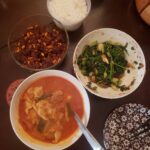
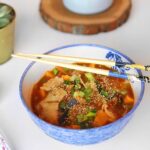
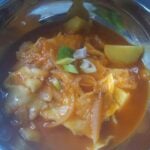
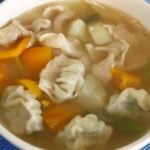

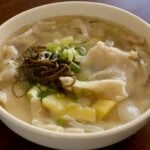



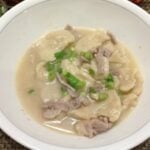
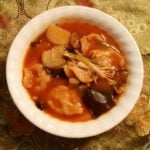
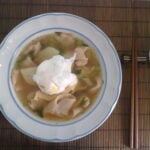
Hi Maangchi,
I’ve already tried and made SOOO many dishes from your recipe. All of my friend LOVE it! you made your video so simple to follow. I made Sujebi many months ago, and I just tried again recently. I just wanna tell you it turned out delicious like usual, and THANK YOU so much for the recipe.
Cathy
Cathy,
yay! good news! Sujebi is very easy to make and the ingredients are very simple. Wonderful!
i’m not korean but i am asian. i really enjoyed this recipe cause it was extremely easy unlike some korean or any recipes. it was really good since i am also a kim chee lover :)
Welcome to my website!! If you can make this recipe easily, I’m sure you can make lots of other recipes, too. Cheers!
Hi Maangchi,
My grandmother makes it with an egg in the dough(This was in Malaysia). As some people say, the flour varies from place to place. I tried using a breadmaker to make the dough as well. If you knead the dough by hand, sometimes you need to slowly add water to get the right consistency. From my trial and error, sometimes, the initial dough is a bit stringy when you pull on it, but after leaving it out for a while, it becomes more stretchy, without the having stringy bits when you pull it to tear. I leave it to stand for a while, covering it with a cloth towel. As for the soup, some of your readers mentioned a meat stock. I use minced pork, anchovies as well as dried shrimp. Prefrying the soaked dried shrimp brings out a nice aroma before making the stock.
I am starting to explore all your recipes and my mouth is watering. Thanks!
Thank you for your tips. Happy New Year!
Hi,
Do I really need the vegetable oil to make the dough? I don’t have any on hand, but I really want to make this.
Thanks, and I love the site.
I think it will be ok.
It was very delicious, even though I had some problems with the dough. First, it was too sticky and watery, so I added more flour, but then I couldn’t tear proper thin noodles, so I kept adding water and flour etc. and eventually I just settled for thicker noodles. Oh well, it was still delicious… but did I do something wrong with the dough or did I just not tear them thinly enough?
It sounds like you already learned a lot from making sujebi! The measurement for the dough is very exact, so next time if you make it again,follow the directions closely. The longer you knead the dough, the better result you will have. I’m sure your next sujebi will be much better. All you need is more practice. Thank you!
Hi Maangchi,
I’m not sure that following precise measurements is the right advice. For pasta and other doughs the conventional wisdom is that the cook needs to play it by ear. The flour to water ratio has so many variables that can effect the correct amounts: humidity, the hardness of the flour, how packed or loose the flour is, etc.
I started with maybe a tablespoon or so less water than the recipe called for and found even then I needed to add a bit more flour.
Thank you so much! I’ve been trying to cook korean food for a long time. I tried using the korean cook books but since my korean is limited, I found it a little confusing. You saved my life! =)
cool! Happy Cooking!
Can I use rice flour instead of regular flour?
Thank you so much for the recipes!! I live in Korea now and it seems that many of my friends don’t know how to make a lot of the food you make. Everytime I ask if they can make something, they say, “No, but my mom can.” I’ve told some of my friends about your site. Keep up the great work and recipes!! ^^
Thank you Rebecca!
Use flour for sujebi making. : )
Hey Maangchi, this recipe is really very similar to what we have in Malaysia called, Pan Mee. It is also hand-torn noodles boiled in broth but the only difference is that we add a bit of meat sauce topping over the top. :)
Your Sujebi looks delicious btw, especially the spicy kimchi version! This reminds me, I have to make another batch of your kimchi soon, i’m running out.
Wow, the cooking method of this noodle soup is cool, the cooking pics are so hd that i can easily follow. I’ll try it later and I hope it tastes the way it look. Thanks for sharing!
Hey Maangchi just want to say thanks for everything you do! I really enjoy your breaded cod recipe as well as the ones for tofu, they were so yummy! Anyway, I made the mild sujebi today, but my soup base came out really bland. It tasted like hot water >< so I was wondering if I should add more fish sauce?? Thank you for reading!
Thank You, Maangchi!My husband loves spicy sujebi. We couldn’t find any local Houston restaurants who knew or were willing to make the spicy version. I’m making it tonight for dinner. He’ll be so happy.
p.s. If you know how to make Andong chicken, a dish that’s slightly spicy and includes cellophane noodles, potatoes and carrots, I’d love the recipe. That was one of our favorite dishes to eat when we lived in Seoul.
You’re the best! Keep these great recipes coming.
Hello Maangchi,
First thank you very much for all your delicious recipes!!! Thank you for sharing and teaching me to cook Korean food. It’s really fun to learn to cook Korean dishes, especially since they are healthier than my own traditional foods,very much lower in fats.
ButI need help!!!!! I’m Puerto Rican but my boyfreind is Korean, his name is Sae Hoon. He is hypertensive and he loves ramen :(, and duk bookie, and all soups. My questions are:
1. Is it possible to make home make ramen/soup stocks that are lower in salt at home? (I’ll make make or buy my own noodle)
2. Do you have any tips on cooking with less salt or salt substitutes?(Cuz the bean and chilli pastes are somtimes salty)
3. Any recipe or other suggestions?
Thank you Maangchi , very very much!!
I cut the potatoes too small and it turned into potato porridge sujebi :(
No problem, next time be brave to cut your potato larger size.
Hi, sujebi people! ; )
Someone asked me through my email about sujebi dough and I answered her with this. I think this information might be useful for you.
“You can keep the dough up to 5 days in the refrigerator (maybe 1 week?), so you don’t have to cook right after making the dough. When you tear it widely and thinly, if the dough is too sticky to tear easily, put some water on your hands, then it will be easier.”
I use exact ingredients for the dough and it was so sticky that I couldn’t knead at all. I don’t know whether the dough can still be used. What’s the purpose of keeping dough in the refrigerator?
No problem! Add more flour to the dough if it turns out too sticky.
Maangchi, the pot that you have the Hot spicy kimchi sujebi in, what do you call that pot? I am trying to find one. I heard the name Naembi? Is that correct? My mother had a small one she used to cook ramen and kimchi in, but my sister took it before I got a hold of it!!
I am hoping to find one at an Asian market, but the one close to me is small, but still hoping!!
yes, the tin pot is called “yangeun naembi”:양은 냄비 in Korean.
I will post the photo on the kitchenware section soon. It’s sold at a Korean grocery store and very cheap.
Thanks soooo much Maangchi!! You are the greatest!
watching this really makes me want to cook again, especially this lol
hopefully i’ll be able to make one that looks that delicious when my new kitchen is all done! XD
I know you like to tear the dough to make thin and flat noodles, right? : )
hey maangchi, what if i just pull it and make them into nooddles.. does that make ramyun ?
Ramyun is made by machine and I don’t know the recipe. You can make “kalguksu (knife-cut noodle soup)” with this dough.
Lastly, how about substituting sweet potatoes for regular potatoes?
It will be unusual sujebi if you use sweet potato. : )
I made this and it was amazing! My mother used to make this for me when I lived at home, but now that I live in another state I can make it myself! I didn’t want to use anchovies, so I used a little bit of beef sliced really thin. I also added a tiny bit of dashida and it was amazing! Thanks for posting!
Great! Some people who can’t eat dried anchovies will get some idea from your comment. Thanks!
!. Can I used whole wheat flour OR whole wheat PASTRY flour for the dough?
2. Can the noodle recipe be made 1 or 2 days advance?
yes, use whole wheat flour and the dough can be kept in the refrigerator up to 4-6 days.
The sujebi shop was closed for many days for the chusok holidays so i did not get to eat it but my husband who is on a short term posting in seoul ate a few times and he said that it is really good! What a pity I missed it! Yes, i know, I know, I should mk it at home…….. Maangchu, if only I were your neighbour!!!!!
I made subeji this morning. I used large anchovies and it was exciting to pinch them open and remove the insides, just like in your videos! Each anchovy just popped open and the guts were very easy to remove. They just brushed right out. I brushed out some of the backbones too, but I don’t think that mattered.
Thank you for leaving your comment here again. Your explanation about how to remove the anchovy guts is very funny. : )
Hahaha, thank you. Once I found out how easy it was, I wanted to pop open all of the anchovies in the pack. It’s pretty fun.
Well maybe you can pop open all the ones I have!! That part really creeps me out! :)
I wish I could. It’s my favorite part.
Angie, I wish I could help you, too! lol
Awww, thanks! :)
Pardon me for my ignorance, I feel amazed when I saw you knead the dough using a food processor. I didn’t know there is such a function. May I know what brand of food processor I should get to knead the dough, it can help saving this lazy girl.
It’s kitchenaid. I can’t live without my food processor! : )
you made my day by adding this. i LOVE sujebi!!!
thank you, maangchi!!!
yay! cheers!
For the kimchi version when should I add the egg?
at the end, just before eating.
The soup is very hot, so the egg will be being cooked while you are eating the sujebi.
Hi there! We do the same in Singapore too! There we call it “mee hoon kuay” : dough pieces, literally. Thanks for this, I’ll definitely try out the Korean version. ;)
Interesting!
haa ya..just that the mee hoon kuay isnt hand-torn..
Oh, but it can be! :) Pan mee is the same thing for mee hoon kuey.
Oh and why do you use the head and body of the anchovies for the first soup but only the body for the second one?? TIA!
You can use the heads in kimchi sujebi, but it will take longer to pick them out. If you make more than 2 servings, put all heads and bodies (oops!) into a tea strainer as I showed in my mild sujebi recipe.
I realised that for both recipe, you didn’t add any meat of any sort. Is that how you all eat it in Korea or is that a personal preference??;)
For the Chinese way, it is pretty similar to the Korean style, just that we commonly use pork ribs to make the stock instead of anchovies:)
Cuisines really are ‘across boundaries’:)
Some people use clams or chicken. I love the flavor of the stock made with dried anchovies.
Hi Maangchi! Thank you for such a wonderful recipe and your great website! I tried Sujebi today- didn’t have potatoes so I used radish instead. It was delicious! I will try it with potatoes next time! :)
Good news! Wow, fast! : )
You can add zucchini, too.
Maangchi ssi, annyeong! Hubby and I enjoy watching your videos so very much! Thanks again for a great recipe! We will make your recipe soon, but on today’s menu is hobak juk, the weather is perfectly autumn out and hobak juk will go well with it! ^^
Kamsahamnida! *hugs*
NEW knife!! ;-)
wow, you are very sharp! btw, the knife is also very sharp! : )
That looks delicious! If I can’t find dried anchovies, what can I use instead?
It’s a good question! I used dried anchovies and dried kelp to make stock in this recipe, but you can use chicken or beef stock too.
That looks really yummy,I’m drooling right now,I’m going to try and make it,I like the spicy one,Thanks.
: ) How did your sujebi turn out? I talked to my sister living in CA over the phone yesterday. She was watching my sujebi video. I asked her what she was going to make for dinner and she said, “I want to make sujebi right now!”
This looks great!
There’s a Chinese version of this, minus the kimchi, and with different ingredients, but the dough is done in exactly the same way…I wonder if it’ll taste the same =)
oh, yeah? I heard that from a few other my YouTube viewers. Chinese version also tear the dough like this? If so, I’m very interested in the recipe. Leave the recipe here if you want:
https://www.maangchi.com/talk/forum/reader-recipes
hi Maangchi! thanks for ur recipe!
the Chinese recipe uses pork ribs to make the stock..i havent tried using kelp..i used soy beans instead to make the soup stock..and i add some sliced shitake mushrooms..its amazing! me and my sis love it!
HAH! First~
i just had a feeling that you will post a new recipe today ^^
This is into my to do list looks so good!!!
yay, cheers! : )